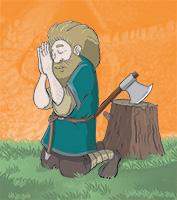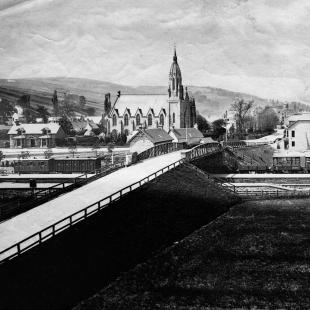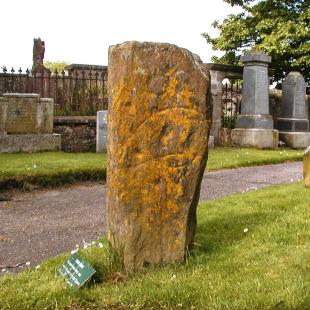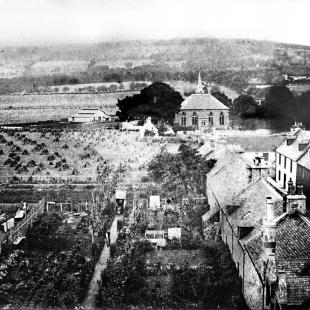
Places of Worship
Through the gates to your right is the two-century-old St Clement’s Church, replacing an older one that in turn replaced earlier ones going back a thousand years on this site. Before the days of Norse and Scot, the Pictish kingdom of Fortriu included here, and in or near this churchyard they raised a stone carved with their strange symbols, or re-used an even older cup-marked one. Whether it was the announcement of an alliance, or of possession, or as a memorial we can not know, but it was repurposed as a lintel in the old church on this site. It now stands just inside the gate.
A thousand years ago there may have been a place of worship here, tied to the Þing site for blessings on the lawgivers and their work. The wide tidal marshlands of the Peffery delta turned the churchyard and nearby Moothill into near islands. The oldest structure within the churchyard is St Clements Aisle, built by (and for) the Kemp family in 1510. In here were interred a century later the Tutor of Kintail and his sons
There are clues to the continuity of church worship in Dingwall over the centuries with entries in tax-rolls and mentions of clerics. Many lived in ‘exciting times’ and one hopes they stood strong for their congregations when plague and war swooped across the area from the times of the Earls of Ross through the Black Death to the Wars of the Three Kingdoms and their aftermath, and the Jacobite wars culminating in the Battle of Culloden in 1746, just 15 miles away. Occasionally the congregations stood against their ministers when national changes—the Reformation, Bishop Laud’s Prayerbook, the Disruption—led to strong feelings on both sides.
Surrounding the church are memorials to the parishioners buried here, including the leaders of their flocks as well as farmers of the land, soldiers, doctors, showpeople, lawyers, sailors, merchants, teachers, and one poor girl murdered by her lover in 1835. The influential Murchison family is remembered on the side of St Clement’s Aisle, a chapel off the main church, built by the Kemp family in 1510 and surrounding the remains of the Tutor of Kintail and his children a century later.
We have many places of worship around the town, some coming from the fracturing and rejoining of congregations, others from newer forms of faith, but there is a continuity here at the centre of the parish.
After the rejoining of elements of the Free Church with the Kirk, the modern church was rededicated to St Clement in 1929, and ministers continue to guide their parishioners here



The Markets
The field to the west of the Church was the site for many years of the Auction Mart, a major centre for the buying and selling of cattle, horses, sheep; brought in by rail to the acres of sidings at the railway station and walked up the High Street to it. The modern Mart opened in 2003 on the southern outskirts of the town and is well worth a visit, especially for its exhibition on the history of droving.
Further Reading
David MacDonald: St Clements Looks Back (1976);
Rev John Kennedy: The Days of the Fathers in Ross-shire (1927);
William Mackay ed: Records of the Presbyteries of Inverness and Dingwall 1643-1688 (1896)
Sponsored by a Private Donation
Do you know something we don't?
Please contact us if you spot an error here or on the panel, or if you have a suggestion for improving the information using »»» this form.

Once you have enjoyed your walk and learning more about Dingwall, you can donate between £1 and £20 by text towards the maintenance and development of the Heritage Trail.
Text DINGWALL to 70450 to give £3.
To donate any other value, add the digit/s: e.g. DINGWALL5 gives £5, DINGWALL12, £12. We, along with over 5500 charities across the UK, trust DONR to collect donations securely.
